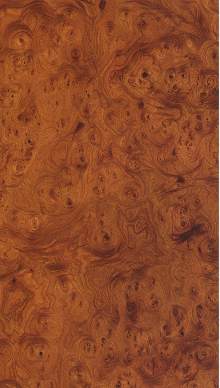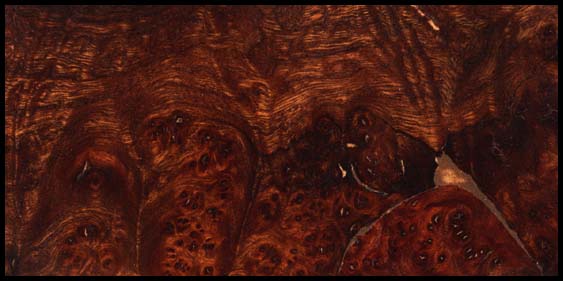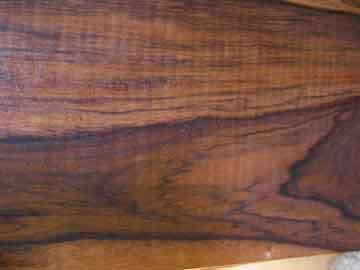

 The Accurate Reloading Forums
The Accurate Reloading Forums  THE ACCURATE RELOADING.COM FORUMS
THE ACCURATE RELOADING.COM FORUMS  Guns, Politics, Gunsmithing & Reloading
Guns, Politics, Gunsmithing & Reloading  Gunsmithing
Gunsmithing  Don't laugh
Don't laughGo  | New  | Find  | Notify  | Tools  | Reply  |  |
| One of Us |
Not being a woodworker I do not know anything of wood choices for gunstocks, other than Walnut being an obvious favorite, with prices following curl and pattern. My nephew, who is a hobbyist maker of fine cedar chests, often uses walnut and cedar combos, as well as mahogany. What is the reason for my not ever seeing a mahogany stock, or a cedar? Not that ugly western red cedar but the nice stuff we have here in the midwest? Too soft, grain problems, what? | ||
|
| One of Us |
Walnut has some of the best weight to strength ratio in addition to having a grain flow that works well with recoil. Walunt is easy to work with (relaitively speaking). Other woods are used, most notably Maple, Birch, Koa, Mesquite. But overall the beauty and grain structure of walnut is preferred. Jim | |||
|
| One of Us |
Remington did use mahogany in some production guns but they were shotguns, not rifles. They made the M58 and a lightweight version of the 1100 20 gauge with mahogany stocks. I have seen two or three custom mahogany stocks on rifles but the owners said that the wood had big (compared to walnut) surface pores that were hard to hide although the 20 Lt Wgt 1100 had that bowling pin finish and looked pretty good. My M58, though, definitely shows the oversize pores. That may be one reason mahogany is not used more. | |||
|
| One of Us |
What the guys above said. Other woods have been used for rifle stocks, like Myrtle, and Mesquite, but the best from a strength to weight ratio, along with beauty, is Walnut. Walnut nominally weighs in at 35 pounds per cubic foot. Myrtle is 10 pounds heavier, and Mesquite is 20 pounds heavier, all per cubic foot. When you use exotic woods, rifle weight goes up. Who wants to carry a rifle that is heavy? I don't, and many others feel the same way. One of the most magnificen woods available is Desert Ironwood, with awesome figure in it. But, it weighs about twice as much per cubic foot as Walnut. Mahogany is just ugly.. My opinion. Don | |||
|
| one of us |
More specifically about cedar, you pretty much answered your own question. Cedar would make an excellent light weight stock if it wasn't too soft for one, and splits so easy, you can usually use a knife. On the positive side, you would never be without fire starter material. Just shave some of your stock off. You would always be carrying a natural cover scent, and those nasty moths wouldn't be so inclined to take up residence in your clothing. Edit: almost forgot, you could leave your gun sit outside for years and the stock would never rot. Jim Please be an ethical PD hunter, always practice shoot and release!! Praying for all the brave souls standing in harms way. | |||
|
| one of us |
If you have your heart set on cedar (and assuming it's not a hard recoiling caliber for your rifle), you can use reclaimed/salvaged cedar from an old barn. On my property here in Tennessee, I have a ramshakle barn from about 1900 with cedar framing. That wood is hard! I plan on using it for furniture when I tear it down, but some of the poles are large enough for a stock. I am sure you could find something similar from a lumbar salvage facility near you. Reclaiming wood from old barns and the like is a big business these days. Garrett | |||
|
| One of Us |
That old barn cedar may be hard, but is it also brittle? My experience with old cedar arrows, tends toward them getting hard...and brittle. Mike Ryan - Gunsmith | |||
|
| One of Us |
FYI Old age is a high price to pay for maturity!!! Some never pay and some pay and never reap the reward. Wisdom comes with age! Sometimes age comes alone.. | |||
|
| One of Us |
one of the biggest factors as to why walnut has become more or less the standard of stock making is it's finishing excellence ,very small pores that are easy to fill with non-filler type oils and because of it's close, stable grain structure, it's ability to hold detailed shapeing/carving. most of the more popular woods used have this same character. there are actually a few more stable woods, mahogany being the first to name, but it's large poors make a fine finish allot of work and it is also a bit more brittle and won't take fine detail very well because of it's porous nature. cherry comes close and was used often in the days of flintlocks where a "poorman's" stock might not be very fancy, but despite finishing excellence being on par with walnut and very stable, it is considerably more brittle than good ole' walnut, so it doesn't hang on to fine detail as well the maples are good and strong, a bit less detail freindly, but too hard on cutting edges.... even big leaf...., good big leaf is hardly softer than sugar maple, but it can have lot's of beutiful figure, i think it's popularity at the time, was due to it's abundance in the colonies and the fact that a nice piece with some good figure would make up for a plainly made stock to get around it's not being too detail freindly. over the years, walnut won out as being the best all-around. as bartshe said, some military stocks were cherry, but there's not much detail in them, so it would work fine. | |||
|
| One of Us |
You can use any wood on planet earth, and no doubt some where someone has done so. There are reasons that stretch through the centuries of gunmaking as to why walnut is preferred, and not all walnut at that. You can use reclaimed cedar. I would not expect the checkering to last longer than a season or two. I might be wrong though. There are many beautiful species of wood out there. Ultimately it is the owners opinion that matters. But if resale is EVER involved in the equation, it is wise to consider only one species. | |||
|
| One of Us |
Some SMLE's used mahogany- those made in the southern hemisphere IIRC, Lithgow's, perhaps. Or was it teak... | |||
|
| One of Us |
No, I just always thought it was a pretty wood, and wondered why it's not seen. | |||
|
| One of Us |
I have BR rifles from Redwood, Walnut, and Cedar. The Redwood and Cedar stocks when laminated with carbon fiber cloth are very strong, but if you look at them very hard they will bruise. Mine have little dents all over them. They are light in weight. Butch | |||
|
| One of Us |
Lithgow started out with Walnut from England. From 1915 - 1940 Queensland Maple was used pretty much exclusively, and from 1940 to the end of production Coachwood was used. These timbers proved perfectly serviceable, though they tend to be a bit plain, and had the advantage of being native and readily available locally. There were experiments with other Australian timbers as well, and in 1919 a couple of sets of SMLEs was made up with stocks in Black Bean, Carabeen, Red Myrtle, Queensland Maple,Blackwood, Crowsfoot Elm and (from New Zealand) Birch, as well as Queensland Maple and Coachwood, to show off the native timbers. Blackwood and Red Myrtle do make attractive stocks too, I've seen a couple of custom examples. As far as Teak is concerned I've seen Teak stocks from India on SMLEs, and while they can be quite attractive they are noticeably heavier than standard Walnut or Coachwood stocked rifles. | |||
|
| One of Us |
There was a great story in the Rifleman many years ago about a guy that had a few "dozen" rifles custom stocked, all in different wood. One was a cross grain Redwood with a doweled forend. I think Fajen did the work.
| |||
|
| one of us |
I've got an Indian one, that sure looks like it's stocked with Mahogany. The real Mahogany, not he Phillipine crap, makes excellent furniture, so why not a gun stock? Availability may be one reason. Grizz Indeed, no human being has yet lived under conditions which, considering the prevailing climates of the past, can be regarded as normal. John E Pfeiffer, The Emergence of Man Those who can't skin, can hold a leg. Abraham Lincoln Only one war at a time. Abe Again. | |||
|
| One of Us |
Too the best of my knowledge NO TEAK was ever used in a gunstock least wise commercially or Militarily !. To dam heavy and difficult to work with . There are several species of woods from around the world which would suffice for gunstock material . 90 % of the market is walnut while the others previously mentioned constitute the other 8.5 % and 1.5 % are exotics . Sitka Spruce This is the strong one. For its weight, it's one of the strongest woods in the world. Color range from light yellow to medium orange. Usually exhibits fairly strong silking (medullary rays). Elm Carpathian as well as Burl   Black Limba West Africa notice the differences in colors from the same genius .    Black Cherry , Hickory , Ash , Mahogany African (Khaya ivorensis) is a prime example of color grain length and density which will exceed or match or may be slightly under that of Walnut !. Depending upon region of harvest Ivory Coast or Gabon is best for Gunstock material . It's neither Walnut nor Mahogany it's a Fool you wood . Deep Red black streaks , yellow black streaks or stripes or purple black with yellow stripes or streaks or nearly black or dark brown with red streaking hues !. I've even seen it black green with yellow red streaks burl figured sound small knots , absolutely beautiful !!. There are so many different species with excellent properties for Gunstocks providing you like some of the colors , as some woods are simply not stainable or permeable and yet others are . One thing is for certain if you're into laminated stocks for beauty as well as strength nearly any combination is suitable as well as affordable mild too wild as the imagination is the only limit !!. | |||
|
| One of Us |
Screwbean Mesquite is one of the most stable and strongest woods that exist for stock making. It is on the heavy side and is Very Expensive for a good blank which are rare. Here is a pic of one of mine(Marlin)that a buddy built for me.. http://www.oldtreegunblanks.com/gallery.shtml | |||
|
| One of Us |
Bois d'arc (Osage Orange) is a very strong wood though I have never heard of it's use as a gun stock. It would interesting to use it since it was preferred by the Osage as a bow wood. | |||
|
| One of Us |
I don't know if that was meant for me, but you are wrong. Teak was used in series production of SMLEs at Ishapore, and plantation Teak is used currently for the stocks of AIA rifles. I have held examples of both in my hands. It does make for an attractive though heavy stock. I understand that Teak has also appeared in the furniture for Yugoslavian M48A rifles, and various SKS and AK variants. | |||
|
| Powered by Social Strata |
| Please Wait. Your request is being processed... |
|

Visit our on-line store for AR Memorabilia

